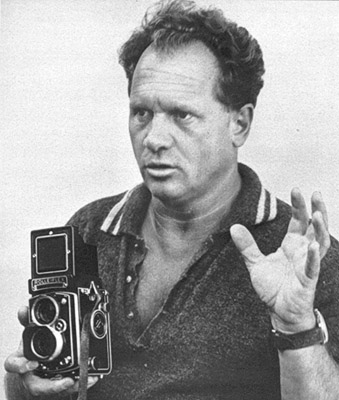
Andre de Dienes - Andre de Dienes was born in Hungary on Dec. 18, 1913. At the age of nineteen, he decided to leave his native country and traveled all over Europe and North Africa, finally settling in Paris, where he became interested in photography. In 1938, he settled in the United States and later became a citizen. He became a freelance photographer for a while but later decided to follow his own instincts and purposely refused all photographic assignments in order to be able to devote himself to the kind of work he most enjoyed. In particular, he wished to photograph nudes. Gradually, he became so involved in this subject and its techniques that most of his time had been given up to it.
Many of de Dienes nudes were impersonal artistic nudes photographed in nature. He traveled extensively just to find the right backgrounds for his models, and the desert and seashore were a few of the locations he found especially suited to his style of photography. Concerning his work, Andre once wrote: "Every picture I have taken of the nude was for the sole purpose of expressing my feelings for the beautiful". When giving advice to other photographers interested in this type of photography, he cautioned them: "I ask you not to disgrace the nude with your camera. Respect it, express its beauty, exercise and better your beautiful emotions. Try not to photograph just naked girls; try to give meaning to your pictures; be proud of the photos you take. Do not abuse the luck and privilege of having a girl pose for you in the nude. Do not photograph nudes as I do, but try your own techniques, give in to your own feelings. Try to create something entirely new, abstract, in any way, as long as it remains within the bounds of decency."
De Dienes is also well known as one of the first major photographers to photograph Marilyn Monroe. Andre and Marilyn traveled extensively together in Dec. 1945, and during this time he took hundreds of photos of her, some of which later ended up on magazine covers throughout the world. Andre de Dienes was also a regular contributor of photos and articles to several photography magazines during the late 40's and 1950's. He also contributed to Playboy during the early years of the magazine. In fact, in the very first issue of Playboy (Dec. 1953), a nude photo of glamour model Diane Hunter that had been taken by de Dienes was featured in the back pages. Diane Hunter would later be photographed by Bruno Bernard, and his pinup of her would be selected by Playboy to make her Miss Nov. 1954 (see my glamour models page for more info).
Other actresses and glamour models that de Dienes photographed include: Elizabeth Taylor, Ingrid Bergman, Anne Francis, Leslie Caron, Jill St. John, Julie Newmar, Barbara Peyton, Yvette Mimieux, Ruth Roman, Carroll Baker, Anita Ekberg, Joan Bradshaw, Pat Crowley, Jeanne Carmen, Judy Crowder, Sara Shane, Arline Hunter, Kathleen Crowley, June Wilkinson, Joyce Winthrop, Marianne Gaba, Colleen Miller, Bobbie Shaw, Jean Peters, Vikki Dougan, Stephanie Griffin, Kathleen Hughes, Joan Tyler and Joan Kerr.
Camera equipment used by the photographer included 4"x 5" view cameras (the Graflex, Graflex D, Auto Graflex and the Linhof Technika) and a Twin Lens Reflex (the Rolleiflex). At least one of Andre de Dienes photo books, "The Nude", was shot entirely with his Rolleiflex, which was also the Medium Format camera of choice by most glamour photographers back in the early to mid 50's. Peter Gowland, Bunny Yeager, Bruno Bernard, Frank Bez, Danny Rouzer, and Sam Wu all used the Rolleiflex during this period. The Rolleiflex uses 120 film which gives an image size of 2 1/4" x 2 1/4". Like most photographers, his was equipped with the Zeiss Tessar 75mm f/3.5 lens, which was highly praised for its sharpness. Andre made sure to always shoot at f/11 or f/16 in order to gain good depth of field and maximum sharpness. Consequently his indoor shots were usually taken at shutter speeds ranging between 1 to 6 seconds and his outdoor shots were usually taken at between 1/50 to 1/500th of a second. Quite surprisingly, he rarely relied on a light meter to determine his exposures. He once wrote "Neither in shooting nor in enlarging do I use a light meter (except for color indoors). My brain becomes a computer and I figure the exposure pretty accurately." He often liked to use Plus-X film in his Rolleiflex due to its fine grain.
Andre de Dienes was one of Bunny Yeager's early influences, and I believe she followed de Dienes technique of shooting at f/11 with her own Rolleiflex, even for nudes shot indoors using available light.
One technique for which de Dienes became well known was his creative way of combining images from two separate negatives onto one photo. He would sometimes spend an entire day on just one or two such photos, dodging and burning the light from the enlarger until he got the seamless effect he was looking for on the developed print. The end result was always a beautiful fantasy image.
Aside from having a photo of Diane Hunter published in the first issue of Playboy, de Dienes also contributed his b&w photos of Playmates Marilyn Waltz (Miss April '54 & April '55), Arline Hunter (Miss Aug. 1954), Joanne Arnold (Miss May 1954), and Dolores Del Monte (Miss March 1954) to the Playboy special edition Playmates: The First 15 Years.
A few of the books that he authored were:
The Nude (1956)
Camera Studies (1958)
Best Nudes (1962)
Figure Photo Techniques (1963)
Sun-warmed Nudes (1965)
Natural Nudes (1966)
Famous Figure Photos (1966)
Nudes, My Camera and I (1973)
Married twice but with no children, de Dienes died of cancer on April 11, 1985. He was survived by his second wife, Shirley T. Ellis de Dienes who preserved, exhibited and licensed her late husband's legendary archive until her death on Nov. 19, 2009 at the age of 69.

Bruno Bernard (aka Bernard of Hollywood) - Bruno Bernard was born in Berlin on Feb. 2, 1912. In Germany, he studied law and criminal psychology and got his Ph.D. in law in 1933. In 1937 he obtained an international fellowship for the University of Berkley, California, where he continued his studies in law, economics and psychology.
When Max Reinhard opened his theatrical workshop in Hollywood, Bruno decided to switch professions. At the workshop, he studied stage and motion picture direction under director William Dieterle. But despite his training, he was unable to get work in the Hollywood studios, so he fell back on his old hobby, photography, for a livelihood. He started out by taking children's portraits. Later, he began to shoot candids of would be actors performing scenes as a sort of "screen test" for the actors to use in their attempts to get work. These "Bernard of Hollywood Tests" circulated among theatrical agents, play producers and studios and soon Bruno had more business than he could handle. In just five short years, he opened six studios in California's most popular resort towns. Slowly, the big stars came to his studios in Hollywood and Palm Springs until he had practically every major star in front of his camera. But these professional clients did not want to be photographed by his trained staff - they wanted Bruno's personal attention. So, he decided to sell all his studios to his assistants and in 1954 moved to Las Vegas to devote himself to the creative aspects of his craft.
Bruno Bernard was another of the photographers to discover the young Norma Jean Baker, who would then go on to become Marilyn Monroe. Bruno's photographs helped Marilyn get her foot in the door at 20th Century Fox (an executive had seen her cover photo from Laff magazine, which had been taken by Bernard), and the two became lifelong friends. Other models and actresses photographed by Bernard of Hollywood include Anita Ekberg, Lili St. Cyr, Mara Corday, Jeanne Crain, Brigitte Bardot, Elizabeth Taylor, Lucille Ball, Zsa Zsa Gabor, Dinah Shore, Marlene Dietrich, Gene Tierney, Janet Leigh, Jayne Mansfield, Julie Newmar, Marilyn Hanold, Eileen Howe, Lorraine Crawford, Rosemarie Bowe and Tina Louise.
In addition to shooting the pinup photo of Diane Hunter, which later became Playboy's Playmate of the Month for Nov. 1954, Bruno also photographed Dolores Del Monte (Miss March 1954), Felicia Atkins' centerfold (Miss April 1958), as well as Marilyn Hanold's Playboy layout (Miss June 1959).
A few books from the 50s and 60s that featured Bruno Bernard's work include:
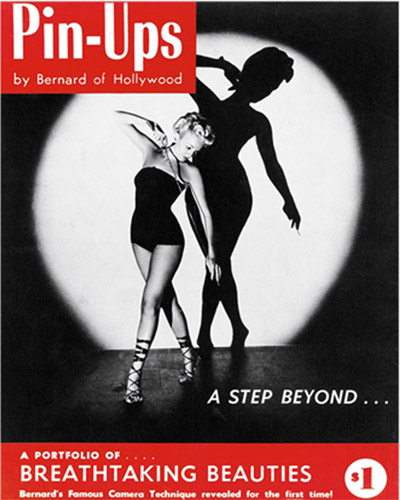
Pin-Ups: A Step Beyond by Bernard of Hollywood (1950)
Figure Photography Annual, Volume Six (the entire issue features Bruno Bernard's photography, including several photos of Diane Hunter - see my models page)
Mood Photography by Bruno Bernard (1962)
Bruno Bernard's Girlography Around the World (1967)
For his studio photography, Mr. Bernard often used large format cameras that included the 4x5 Speed Graphic, 5x7 Ansco view camera, Super D Graflex and Auto Graflex. Outside the studio, he generally preferred to use his Rolleiflex for B&W work, which gave a 2 1/4" x 2 1/4" negative. For this type of work, he relied on Kodak films such as Plus-X, Tri-X and Panatomic X, the first two of which are still staples of the B&W film shooter today.
Bruno's daughter, Susan, became Playboy's Playmate of the Month for Dec. 1966. Her centerfold was photographed by Mario Casilli, with Bruno supplying a few B&W photos of Susan, fully clothed, to the layout. Susan had also been chosen by another glamour photographer (turned movie director) Russ Meyer, to have a role in his 1965 exploitation film Faster, Pussycat! Kill! Kill!.
Bruno Bernard passed away on June 3, 1987, at the age of 75, after a four year long battle with cancer. His daughter Susan created a website dedicated to his memory and his work and can be seen at www.bernardofhollywood.com
Update: Susan Bernard, daughter of Bruno Bernard and Playboy's Playmate of the Month for Dec. 1966, passed away of an apparent heart attack on June 21, 2019. She was 71 years old. Update #2 (2/22/2022): Bruno Bernard's photographic legacy is now under the management of his grandson, Joshua John Miller, and Mr. Miller has recently updated the Bernard of Hollywood website.
Books on Bruno's Bernard's photography that have been written and edited by Susan Bernard include:
Bernard of Hollywood's Marilyn (1993)
Bernard of Hollywood Pin-Ups: Brunettes! (1995)
Bernard of Hollywood Pin-Ups: Redheads! (1995)
Bernard of Hollywood Pin-Ups: Blondes! (1995)
Bernard of Hollywood: The Ultimate Pin-Up Book (2002)

Sam Wu - Samuel Wu was born in Boston, Massachusetts on Feb. 19, 1919, and was raised in Canton, China. Art was his favorite subject in school and his interest in photography grew out of his passion for painting. Three months before Pearl Harbor, Sam returned to the United States and settled in Southern California, where he went to work for Lockheed Aircraft as a photographer.
After the war, Sam Wu turned to fashion photography in Hollywood and became interested in the interpretation of the human figure. Although many people associated his name with glamour, 50 per cent of his work was in the industrial and commercial fields.
Some of the actresses and models that Sam Wu photographed include: Debbie Reynolds, Natalie Wood, Anita Ekberg, Barbara Parkins, Jayne Mansfield, Marla English, Doris Gohlke, Nobu McCarthy, June Wilkinson, Pat O'Connell, Vivian Maledy, Dolores Greer, Jeanne Carmen, Joan Webb, Vikki Dougan, Marilyn Hanold, Quinn O'Hara, and Gloria Dawn.
Camera equipment used by Mr. Wu included a Rolleiflex (medium format camera) and 35mm Canon and Pentax cameras. For his B&W work, he used Plus-X for outdoor shots and Tri-X indoors. The color transparency films he preferred were Daylight Ektachrome for outdoors and Ektachrome Type F indoors. The 35mm format became his preference for shooting glamour in the late 50s. In 1957, he wrote: "These are the qualities that make the 35mm camera my choice for glamour assignments: compactness, ease and speed with which I can handle it, and light weight. The last item - weight - is important to me, because I'm a small fellow and heavy equipment wears me out quickly." For his 35mm cameras, he preferred to use a normal 50mm lens for outdoor work and a wide angle 35mm lens indoors.
For illumination, he liked to use either the great outdoors or natural window light indoors. If he had to use artificial light, he would use bounced strobes, which spread soft even illumination over his subjects and backgrounds, giving an effect very similar to natural daylight.
Sam Wu occasionally wrote articles for the various photography magazines of the day, including Popular Photography and Candid Photography.
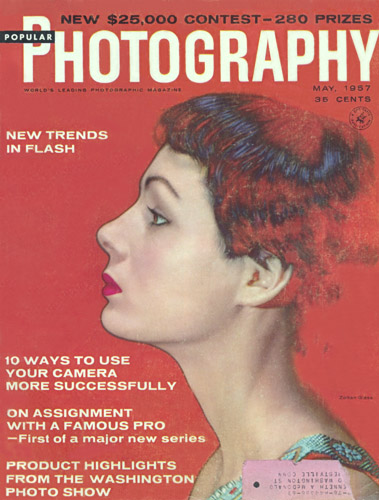
Popular Photography (May 1957) featuring an article by Sam Wu called "How a Hollywood Pro Shoots Glamour with a 35"
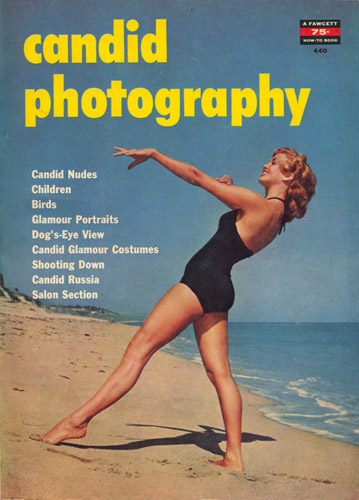
Candid Photography (1960) featuring a Wu article on "Candid Glamour Costumes"
Other magazines that featured the glamour photography of Sam Wu included Argosy, Caper, Cavalier, Modern Man, Rogue, Esquire, U.S. Camera, and Pageant.
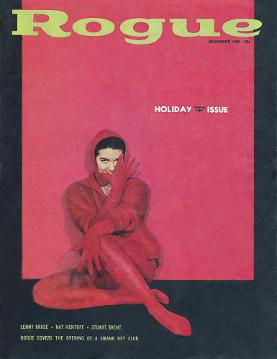
The cover of the Dec. 1959 issue of Rogue magazine, which was shot by Sam Wu.
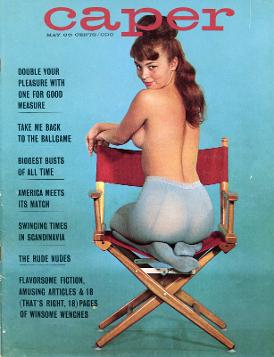
Another Sam Wu cover, this one from the May 1964 issue of Caper magazine.
Sam Wu authored two Whitestone photo books in the 1960s:
Photo Study Techniques (1960)
Sam Wu's Hollywood Figure Studies (1967)
Sam also photographed three Playmates for Playboy:
Rusty Fisher (Miss April 1956)
Pat Sheehan (Miss Oct. 1958)
Christa Speck (Miss Sept. 1961)
In addition, Sam Wu photographed Tania Velia (former star of the Yugoslavian swimming team) for the July 1959 issue of Playboy.
Mr. Wu's main photographic influences were Irving Penn, Richard Avedon, Gordon Parks and Henri Cartier-Bresson. He remarked: "Their style and their imagination with the camera has inspired my own methods". With respect to his glamour photography he had this to say: "I like to use photography to show the beauty of women in relation to nature, in relation to time, in relation to mood and feeling."
Sam Wu passed away in Los Angeles, California on August 19, 2005. He was 86 years old.
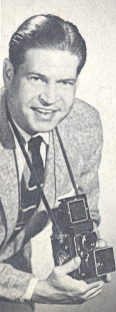
Danny Rouzer - Danny Rouzer was a Hollywood glamour photographer who had studied under the somewhat controversial William Mortensen (some photographers like Ansel Adams despised Mortensen's work). Danny Rouzer's figure photography appeared in many photo and art magazines throughout the 1950s and he was also the official photographer for the 1956 Miss Universe contest, held in Long Beach, CA.
Danny Rouzer was born in Houston, Texas on August 17, 1919 and after high school attended the University of Iowa. Several months after the U.S. entered WWII, Danny enlisted in the Army and served until July 9, 1946. After his discharge, Danny initially had an interest in cinematography, but finally settled on photography and opened his own studio in Los Angeles (7022 Melrose Ave.) in 1949.
Many of Mr. Rouzer's excellent nudes were featured in such Fawcett and Whitestone publications as Good Photography, Candid Photography, Salon Photography and Prize Winning Photography. Along with other genres of photography, these books always included a good selection of artistic nudes and glamour.
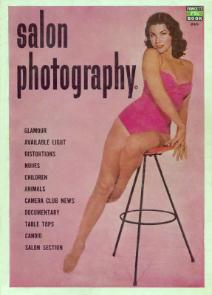
Salon Photography (1954) - featuring an article by Danny Rouzer on "Outdoor Nudes".
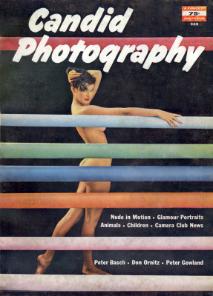
Candid Photography (1958) with an article by Mr. Rouzer entitled "The Figure in Motion".
Danny Rouzer authored his first photography book in 1956, entitled Danny Rouzer's Glamour Photography. His second book, Danny Rouzer's Figure Photography was published two years later. Along with Peter Gowland, Bunny Yeager, Ron Vogel, Russ Meyer, Keith Bernard and David M. Mills, Mr. Rouzer was privileged to work with the famous figure model Diane Webber, and some of his photos of her are quite striking, including some ballet inspired images (Diane had been a ballet dancer). Another of Rouzer's favorite models was Anne Fleming, who had been Playboy's Miss Sept. 1955.
Camera equipment used by Mr. Rouzer included the Rolleiflex (which he is holding in the above photo) and a 4"x 5" Graflex. He was also partial to Gevapan film, which was manufactured in Belgium.
Danny Rouzer also contributed to Playboy. For the Playboy special edition Playmates: The First 15 Years (1983), they used some of his photos of Diane Webber and two other Playmates (Margie Harrison and Madeline Castle).
Later in life, Danny Rouzer became a charter member of The Magic Castle in Los Angeles and often performed there, doing close-up magic. To see Danny performing magic tricks, google "magician Danny Rouzer" and you will find two videos of him from the early 80s.
Mr. Rouzer, born Walter Daniel Rouzer Jr., passed away in Los Angeles on Dec. 31, 1984 at the age of 65. He was interred in Forest Lawn Memorial Park in Glendale, California.
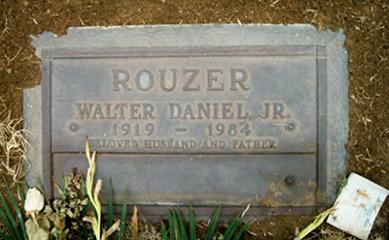
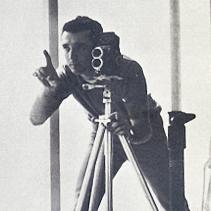
Frank Bez - When Frank was a boy in public school in Riverside, Illinois, he was given music lessons...and an old Kodak camera, a gift from his dad. Young Frank was a musical whiz, but his hobby was the beat-up camera, with which he was already making money, taking pictures and doing his own developing. For his school friends, he photographed parties and games, and in addition, their parents had him busy covering weddings and special events. At 13, he gained technical experience by working part-time for a photo finisher.
Frank's musical interest continued, but in junior college he decided music was too demanding, so he turned again to his camera and studied photography at Illinois Tech, later instructing a photographic class at the University of Illinois. His first real job, at 19, was in Chicago in cinematography, as assistant director for producers of classroom films.
Joining the army in the Korean war, Frank spent most of it in New York, and when released, moved to Southern California to enter UCLA. He later quit school to work for Hollywood photographer Sid Avery, who encouraged him to freelance in still photography. The career that started with a hand-me-down camera, bloomed in Hollywood, as his pictures were seen in many of the leading national magazines. Bez' love affair with the still camera persisted, with the result that his photographs of beauty were in high demand.
Camera equipment used by Bez included the 500 C Hasselblad, The Rolleiflex and Tele-Rollei, as well as the Nikon F (35mm) and, of course, the larger format cameras that were necessary for his work with Playboy.
Some of the actresses and models that Frank Bez photographed include: Jean Rainier, Chris Noel, Laura Cummings. Jan Moriarty, Nancy Vann (for Cavalier magazine), Cathy Crowfoot, Paula Angelos, Darlene Tomkins, Judy Treadway, Brooke Mills, Kathy Kersh, Shelley Fabares, Connie Stevens, Juliet Prowse, Stella Stevens, Jill St. John, Julie Newmar, Lee Remick, Tuesday Weld, Barbara Parkins, Angie Dickinson, Kim Novak, Elizabeth Montgomery, Ann-Margret, Mary Tyler Moore, Raquel Welch, Nancy Kwan and Jane Fonda.
Frank photographed 5 Playboy Playmates of the Month:
Linne Nanette Ahlstrand (Miss July 1958)
Donna Lynn (Miss Nov. 1959)
Ginger Young (Miss May 1960)
Susan Kelly (Miss May 1961)
Merle Pertile (Miss Jan. 1962)
Frank Bez was also one of the photographers who photographed Ellen Stratton, Miss Dec. 1959, for Playboy (her original Playmate and PMOY pictorials were shot by William Graham, however). Bez' images of Miss Stratton are just amazing, and are among some of the photos that she sells to fans on her web page. She has always been one of my favorite Playmates, and incidentally, was nice enough to sign my copy of the June 1960 issue of Playboy, where she was named the first Playmate of the Year.
Other Bez contributions to Playboy include a beautiful 7 page pictorial of Carroll Baker in the Dec. 1964 issue, a photo spread on Kim Novak in the Feb. 1965 issue called At Home with Kim and a pictorial on Carol Lynley in the March 1965 issue entitled Carol Lynley Grows Up.
Mr. Bez wrote one book for Whitestone Publications entitled Frank Bez Photographs Face and Figure (1964), but was also published in several other books of the era, including Famous Photographers Photograph Beautiful Women (1963) and Figure Studies by Famous Photographers (1965). He also contributed his photos to many magazines such as Esquire, The Saturday Evening Post, and Cavalier.
According to a recent report, Frank Bez has semi-retired from photography to again concentrate on his music. He currently resides in Avila Beach, California.
Update: Frank Bez now has a Facebook page and you can also buy prints of his work at http://frank-bez.pixels.com/
Update #2: I am sorry to report that Frank Ronald Bezkostny, aka Frank Bez, passed away peacefully in Paso Robles, CA on May 26, 2018, at the age of 87. Frank was born in Riverside, Illinois on Sept. 14, 1930. At the current time, Frank's Facebook page is still up.

Mario Casilli in 1957, posing with model Jacquelyn Prescott, the first Playmate he photographed for Playboy magazine. The lovely Miss Prescott appeared in the Sept. 1957 issue.
Mario Casilli - If there was one photographer who contributed the most to the look of 1960's era Playboy, it would probably have to be Mario Casilli (with Pompeo Posar being a close second). From 1957 to 1969 (the years we're considering here, as he actually continued to photograph Playboy Playmates up until 1981), he contributed to an astonishing 32 Playmate of the Month pictorials, as well as 4 Playmate of the Year pictorials.
The 50s and 60s Playmate centerfolds that he shot were:
Jacquelyn Prescott (Miss Sept. 1957), Cheryl Kubert (Miss Feb. 1958), Susie Scott (Miss Feb. 1960), Linda Gamble (Miss April 1960), Kathy Douglas (Miss Oct. 1960), Barbara Ann Lawford (Miss Feb. 1961), Tonya Crews (Miss March 1961), Heidi Becker (Miss June 1961), Karen Thompson (Miss Aug. 1961), Dianne Danford (Miss Nov. 1961), Pamela Ann Gordon (Miss March 1962), Unne Terjesen (Miss July 1962), Toni Ann Thomas (Miss Feb. 1963), Sharon Cintron (Miss May 1963), Victoria Valentino (Miss Sept. 1963), Christine Williams (Miss Oct. 1963), Melba Ogle (Miss July 1964), Astrid Schulz (Miss Sept. 1964), Jo Collins (Miss Dec. 1964), Jessica St. George (Miss Feb. 1965), Gay Collier (Miss July 1965), Judy Tyler (Miss Jan. 1966), Priscilla Wright (Miss March 1966), Sue Bernard (Miss Dec. 1966), Fran Gerard (Miss March 1967), Gwen Wong (Miss April 1967), Anne Randall (Miss May 1967), DeDe Lind (Miss Aug. 1967), Elizabeth Jordan (Miss May 1968), Leslie Bianchini (Miss June 1969), and Debbie Hooper (Miss Aug. 1969).
The Playmate of the Year pictorials that Mario shot during those years were:
Linda Gamble (PMOY for 1961), Christa Speck (PMOY for 1962), Jo Collins (PMOY for 1965) and Connie Kreski (PMOY for 1969).
While I have tremendous admiration for Mario Casilli's excellent work for Playboy, I have to say that I'm a bit divided (and sort of confused) by some of his other glamour work from the late 50s and early 60s. In particular, his B&W medium format glamour images. The apparent differences in quality make it hard for me to reconcile the fact that all of these photos had even been shot by the same photographer. There just wasn't the attention to detail that was so prevalent in his color work for Playboy. Perhaps B&W was just not his medium.
Mario Casilli was born on Jan. 22, 1931 in Cleveland, Ohio. As far back as his elementary school days, Casilli set his sights on a career in photography. At twelve, he was winning prizes in photography contests and tinkering in the darkroom with developing innovations. At 14, he won a scholarship to the Cleveland Institute of Arts. After graduation, he served in the Navy, working as an artist and lithographer. When his hitch was over, he moved to the glamour capital of the world, Hollywood, and secured a job at the Paul Hesse studio. He worked with Hesse for four years, polishing his technique and learning about the photography business. After one particular shoot, Hesse had 2 sheets of 8x10 film left over, so he gave them to Casilli. At home, Mario built a set, photographed a model with one sheet of film, then built another set and photographed another model with the second sheet. Then he sent the shots to Playboy and the magazine bought them for $3000 each. I believe one of those photos was his Playmate centerfold of Jacquelyn Prescott, who became Miss Sept. 1957 (all Playboy centerfolds were required to be shot on 8x10 color transparency film, of which Mario was well aware). Playboy Photography Editor Vince Tajiri was so impressed with Mario's photography that he quickly hired him as a staff photographer. Casilli then opened a studio on Sunset Boulevard, which became Playboy's first unofficial presence on the west coast.
In the late 50s and early 60s, Mario Casilli was also contributing his photos to other men's magazines, as well as photography books such as Good Photography and Candid Photography. His B&W images often appeared in the "Modern Art for Men" section of Modern Man magazine, and he shot pictorials for Rogue as well. It was in these magazines and books that I first saw some of Casilli's B&W work. In 1963, Mr. Casilli authored his own photography book entitled "Mario Casilli's Hollywood Models".
Camera equipment used by Mr. Casilli included the Rolleiflex and Hasselblad 500 C (with 150mm lens) for medium format, a 35mm Nikon F and an 8x10 Deardorff with a 14" Ektar lens.
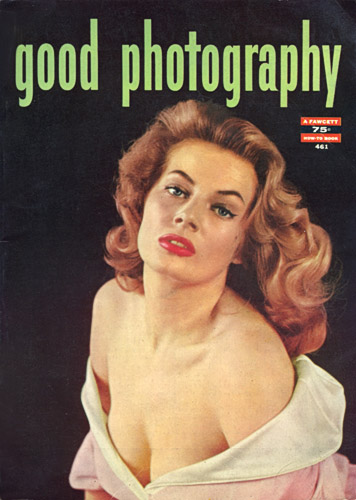
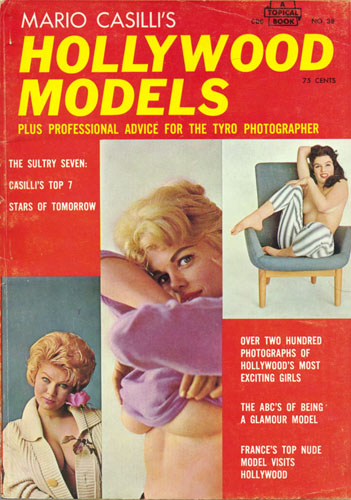
Good Photography (1960) Mario Casilli's Hollywood Models (1963) featuring an 8 page article on glamour props authored by Mario Casilli
Mr. Casilli continued to work for Playboy throughout the 1960s and 70s, shooting over 70 Playmates and dozens of celebrity pictorials. He left the security of life as a Playboy staffer in 1979 to explore other photo opportunities, but he continued to work for the magazine on a regular basis, photographing such memorable Playmates as Dorothy Stratten, and several Playboy covers, one of which featured Barbra Streisand. Casilli's Pasadena photography studio and home became a meeting place for celebrities, as they vied for the next cover of TV Guide, Playboy or the dozens of other magazines to which Casilli regularly contributed.
Mario Casilli died on April 25, 2002, following a stroke. He was 71.
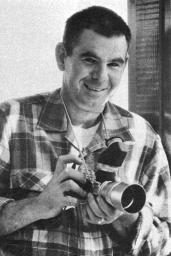
Russ Meyer - In 1956, Russ Meyer wrote these words: "It is a peculiar condition of the photographic field that every professional cameraman specializes in particular types of pictures. As a professional, I probably have taken pictures of more full- figured women than any other person working behind the shutter."
For those who are familiar with Russ Meyer's work in the glamour photography field, as well as in his later foray into the exploitation film market, that pretty much sums it up. Most of Meyer's models were, in his own words "well-stacked on top; look well fed and vibrant."
In the army, Russ made friends with Don Ornitz, another combat cameraman. Some years later, Don, who was already an established photographer of girls, suggested to Russ that he leave San Francisco and his job as an industrial documentary cinematographer, to come to Hollywood and become a glamour photographer instead. That was exactly what Russ Meyer did.
Here, we will just deal with Meyer's job
as a glamour photographer in the 1950s and 60s. During this time, he
shot for Playboy and other mens magazines, as well as submitting his
work to photography magazines such as Good Photography and Candid
Photography, which always featured artistic nude and glamour
photographs. Some of his models included his wife, Eve Meyer, as well as
Anita Ekberg, Diane Webber, June Wilkinson, Mona Miller, Dawn Richard, Fay Spain, Mia Morina, Suzanne Lloyd, Mary Jane Peters, Donaldo Jordan, Iris Bristol and Joyce Winfield.
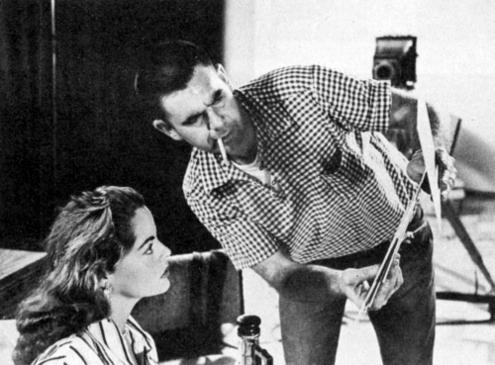
Camera equipment used by Meyer for his
b&w glamour photos was either a 35mm Leica or Nikon camera. He
relied heavily on the Nikon, though, because of the 105mm f/2.5 Nikor
lens, which he felt gave exceptional results. For color work, he
occasionally used 35mm, but more often used a Rolleiflex or Hasselblad
due to the larger negative size of 2 1/4" x 2 1/4" (most editors shied
away from 35mm color because of reproduction problems). For his work
with Playboy, Meyer also had to use large format cameras.
Russ Meyer photographed three Playmates for Playboy magazine. The first was his wife, Eve Meyer, Miss June 1955, followed by Marguerite Empey (Diane Webber), Miss Feb. 1956, and finally, Yvette Vickers, Miss July 1959. Diane Webber had already been a Playmate of the Month in 1955, having been photographed by Hal Adams, but Russ Meyer had not been aware of this, and submitted his photos, which were also accepted by Playboy.
Meyer died at his home in the Hollywood Hills, of complications of pneumonia, on September 18, 2004. He was 82 years old, and had been suffering from Alzheimers since 2000.
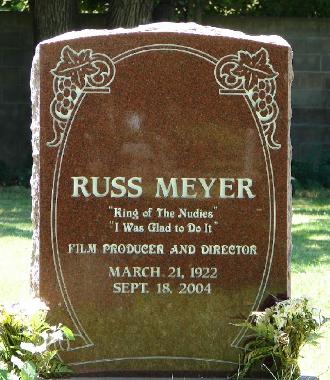

Ron Vogel - Ron Vogel was quite a prolific glamour photographer in the 1950s and 60s, but I have relatively little biographical information about him. Some information that I did find was that he was born on Oct. 7, 1931 and that his wife Audry gave birth to a daughter, Alexis P. Vogel in 1957 (Alexis is now a sought after makeup artist) and a son, Ronald B. Vogel in 1960. Update: Ron's daughter Alexis passed away on April 14, 2019 at the age of 61.
It was through the hobby facilities of the Army's Special Services that Vogel received his first basic training in camera technique, and those lessons contributed a great deal to his eventual success as a photographer. Shortly after his discharge from the Army, Ron began aiming his camera at the female figure. His first model was his wife Audry, and this arrangement was a big help in getting him over his critical launching period. His pictures of her received almost instant approval from magazine editors.
Ron eventually became a frequent contributor to magazines such as Playboy, Modern Man, Rogue and Adam as well as many of the smaller men's magazines of that era. It almost seemed that throughout the early 1960s, Ron had at least one pictorial in every single issue of both Modern Man and Adam. In fact, Modern Man sometimes referred to Vogel as their "Chief Camera Clicker", and he would often photograph two of the main photo layouts in the issue as well as contributing a few images to their "Modern Art for Men" section, which showcased artistic nudes from various glamour photographers. Some of Ron's many contributions to Rogue included the main pictorials in the following issues: Dec. 1960 (Ann Vila), Jan. '61 (Virginia Gordon), Feb. '61 (Margie Friend), May '61 (Jean Jani), Sept. '61 (Barbara Bacon), Jan. '62 (Tina Gamwell), Feb. '62 (Judy Treadway), March '62 (Betsy Gray), May '62 (Laurie Kaplan), July '62 (Pat Bryan), Aug. '62 (Rhonda Cliff), Oct. '62 (Cathy Crowfoot), Jan. '63 (Judy Berrow), March '63 (Mary Lou Terry), April '63 (Marian Robinson), May '63 (Ruby Carlson), June '63 (Donna Hennebury), July '63 (Kathy Fields), Sept. '63 (Terri Nichols), Dec. '63 (Diana Rylands), Oct. '65 (Sandy Noble) and Dec. '65 (Marcie Chandler). The Feb. '62 and July '62 issues featured an additional pictorial by Ron Vogel, so in some issues of the magazine his work was featured more than once, just as in Modern Man.
Ron was also a frequent contributor to the Fawcett and Whitestone photography magazines such as Good Photography and Candid Photography in the late 50s and early 60s, again showcasing some of his artistic nudes, along with many of the other glamour photographers of the day.
Ron photographed 10 Playboy Playmates between 1958 and 1968. They are:
Lari Laine (Miss May 1958)
Joan Staley (Miss Nov. 1958)
Virginia Gordon (Miss Jan. 1959)
Eleanor Bradley (Miss Feb. 1959)
Jean Cannon (Miss Oct. 1961)
Carrie Enright (Miss July 1963)
Nancy Scott (Miss March 1964)
Hedy Scott (Miss June 1965)
Reagan Wilson (Miss Oct. 1967)
Gale Olson (Miss Aug. 1968)
In addition to his glamour work, Mr. Vogel also did some business in the lucrative advertising and commercial photography fields, as well as receiving occasional assignments from magazine editors to photograph celebrities.
Some of my favorites of Ron's Playboy photos are of the beautiful Reagan Wilson (Miss Oct. 1967). He also shot many excellent photos of Gloria Dawn for other men's magazines (see my glamour models page) and Miss Dawn may contribute some of her memories of working with Ron on this website in the near future. Ron also worked with popular glamour model Diane Webber as well as Lois Mitchell, both of whom became well known for their work with Peter Gowland. In fact, Gowland also photographed both Reagan Wilson and Gloria Dawn (it was Gowland who first discovered and photographed Gloria Dawn).
But unlike Peter Gowland, who stayed true to his own classic style, Ron Vogel became involved with porn films once glamour photography became more overtly sexual in the 1970s and 80s, as unfortunately there was less demand for Ron's classier glamour style of the 1950s and 60s.
Ron Vogel passed away in 2019 at the age of 87 or 88. He had been suffering from Alzheimers for many years and during the last several years of his life, he was no longer able to communicate. Note: In 2020, someone related to Ron's ex-wife Audry had created a family tree on Ancestry.com which listed Ron as having passed away in 2019. However, no exact date of death was given.
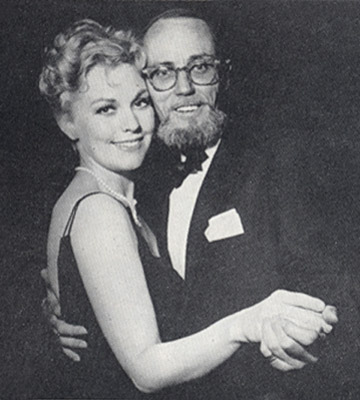
Earl Leaf - Although not as well known as some of the other glamour photographers, I'm including him here as he was one of the photographers of Marilyn Monroe, as well as countless other Hollywood starlets and glamour models of the 1950s and 60s. He also contributed photos to several men's magazines of the era, such as Rogue and Modern Man. In a 1962 article in Modern Man, it was written of Leaf: "Far from being Hudson or Brando, wiry, whiskered Earl Leaf nonetheless leads life most men enjoy only in dreams". They went on with a rather humorous description of Leaf: "To most Hollywood newcomers, the man who calls himself Earl Leaf looks like something left behind by a flood. He is a walking cornstalk with the craggy features of weathered driftwood, a seaweedy beard, large luminous eyes that peer from deep window-covered holes and an Adam's apple that would choke a water buffalo.". Despite the above description, Earl Leaf had a charm that endeared him to many a Hollywood actress and glamour girl. In fact, in a 2004 interview, glamour model June Wilkinson remarked: "Earl Leaf was a lot of fun to shoot with. He always made me laugh and I will remember him forever because he's the one who taught me how to drive. And I got my license to drive a car because of him."
Leaf took a rather circuitous path to becoming a Hollywood cheesecake photographer. He was born in Seattle, Washington on Aug. 25, 1904 and moved to San Francisco at a young age. He served in the Navy, and although he never finished grammar school, he somehow landed a job as a reporter for The San Francisco News. This led to a job with United Press, a world-wide news agency, followed by a position as editor of the Nevada State Journal.
Seeking adventure, just before WWII, he managed to obtain employment in China and after working for a few newspapers, he became editor of the Manchuria Daily News. In 1938, Leaf slipped through the Chinese Nationalists lines into Chinese Communist territory to become the North China Manager of United Press. During the war, he served as an advisor to Chiang Kai-shek and operated as a secret agent for the O.S.S. (Office of Strategic Services, the forerunner of today's CIA). In this capacity, he was able to take photos of the Chinese Communist leaders with a cheap box camera - photos that would launch his camera career. The images were published in Life, Time, Look, Newsweek, Colliers, New York Times and dozens of other newspapers and magazines.
After the war, he landed in the West Indies where he lived for a short time and wrote the book "Isles of Rhythm" (1948). Then he toured Europe and Latin America and several other countries before he wound up in Hollywood in 1950, eventually becoming staff photographer and west coast editor for Movie Play, MovieTime, and Movie Spotlight magazines.
In his job as Hollywood publicity man and all-around glamour photographer, Mr. Leaf had close associations with many leading Hollywood stars and glamour girls in addition to dozens of hopefuls who were looking to break into the film business by posing before his camera. Some of his acquaintances and close friends included Kim Novak (pictured with Leaf above), Marilyn Monroe, Jayne Mansfield, Liz Taylor, Tuesday Weld, Joanna Moore, Shirley MacLaine, Debbie Reynolds, Natalie Wood, Susan Oliver, Dorothy Malone, Joan Collins, Rhonda Fleming, Fay Spain, Barbara Nichols, Anita Ekberg, Julie London and Linda Christian. A few of the glamour models that Leaf worked with included June Wilkinson (mentioned above), Marla English, Kathleen Hughes, Mamie Van Doren, Elsa Sorensen, Dolores Donlon, Bonnie Logan and Joan Bradshaw.
Leaf met Marilyn Monroe in 1950, when she was still struggling to break into movies, and the two became good friends. He continued to photograph her during most of her career, and many of his photos of her would later be published in the book "Marilyn Monroe: From Beginning to End" (1997).
In 1958, Earl Leaf wrote the book "Photographing Women of the World", which featured some of his many photos of women up until that time.
In 1959, Leaf remarked that the only camera that he cared to use was his "beloved Rolleiflex". His favorite general purpose B&W film was Verichrome Pan, but he always kept Tri-X on hand in case he needed something faster. For color film, he used Ektachrome (transparency film).
By the late 50s and through the 1960s, Earl had a regular column in Teen magazine and began writing about music and photographing some of the top bands of the day. A few of the books he authored (well, magazines really) about The Beatles were "The Original Beatles Book" and "The Original Beatles Book Two" (both 1964).
By all accounts, Leaf was an eccentric man who never took himself too seriously and was beloved by many who knew him.
Earl Leaf died of emphysema on Feb. 5, 1980 at age 75, leaving behind a vast number of vintage photographs and negatives that were later purchased by the Michael Ochs Archives.
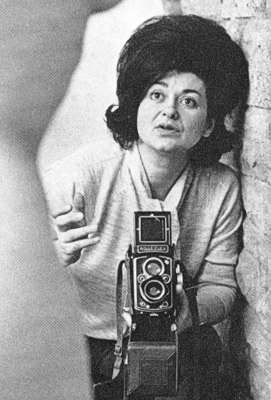
Eva Grant - One of several London glamour photographers that I intend to profile on this site is Eva Grant. I only became aware of this photographer's work a few years ago when I saw some of her photographs in several of the Good Photography and Candid Photography books (Whitestone and Fawcett Publications). What I saw in those books were tasteful images of beautiful buxom models and I was quite impressed. I wanted to know more about Ms. Grant and after a little research, I came up with the following information:
Eva Grant was born in Athens, Greece on March 25, 1925 and at the age of 22, decided to leave Athens and head for London. To earn a living, she worked for three years at London's Shanley Mental Hospital where she scrubbed floors and performed other menial duties. During this time, Eva attended a party where she met a professional photographer who asked her to pose for him. After some initial hesitation, she agreed. She soon learned about posing for the camera and as her modelling fame spread, she was flooded by job offers from other photographers. Very early on, though, she realized that she was on the wrong side of the camera. She too wanted to express her creativity in the field of glamour photography. She never had a minute of formal instruction in photography, though, other than getting some basic knowledge of focusing and exposure from several of her London photographer friends. Eva began her full time pursuit of a career in figure photography in 1951.
Eva Grant was another photographer who seemed to have been influenced by William Mortensen (Danny Rouzer and Bruno Bernard, who are also profiled on this page, were fans of Mortensen) after a friend gave her several of the photographer's books. In a 1964 interview she remarked: "I think I got more from William Mortensen than from any other single source. However, I've never called myself a technician. A battered old Rollei - this one - has served my purposes for years and I seldom mess around with fancy combinations of film and developer. It's just the picture that interests me."
In 1956, Eva came to the United States to see the work of this country's top glamour photographers. She paid particular attention to the work of Andre de Dienes, Peter Gowland and Peter Basch and found their approach thrilling. "Flawless taste, faultless technique, a refined sense of animal symmetry and natural lighting. I went back to England determined never to take another picture by studio lighting - and I never have." Eva also realized from this trip that the U.S. was the only place for her pictures. "The American market is the only satisfactory market for European figure photographers who aspire to more than a naive or stilted approach. Perhaps the Americans appreciate women more, corny as it may sound."
A few of Eva Grant's glamour models included: Adele Roman, Karen Sterling, Kathleen Cooper, Sabrina, Heather Bridgeman, Lynn Shaw, Lee Sothern, Crystal Dawson, Diane duBois, Beryl Ash, Lavinia Grant, Rosa Dolmai, Grace Jackson, Vicky Gray, Wendy Clifford, June Palmer, Sophie Dorn, Hazel Oliver, Anita Baldrey, Gina Graham and Sally Ann Scott.
After having viewed more of Eva Grant's work, I have to say that I think her work was a little bit hit or miss. She did take some incredible shots of several gorgeous models (click here to see one of them), but in a few of her nude images, I've not been overly enthusiastic about the models' poses. The most jarring aspect of her nude photography (from an American perspective) was her occasionally choosing to photograph her models from a "full frontal" angle and then erasing the models pubic area when making the prints (this appeared to be the British style of the time as Zoltan Glass did the same thing). It is my belief that for tasteful and artistic nude glamour images, the pubic region should be covered or hidden by the proper angle or pose. Intentionally photographing this area of the body and then defacing it in the finished print is both distracting and grotesque, in my opinion. Choosing a different pose could have easily eliminated these distractions.
You can see Eva's work by obtaining some 50s and 60s photography books (issues of Good Photography, Candid Photography, Salon Photography and Prize-winning Photography can often be found on ebay for reasonable prices) or Figure Annual (Spring 1964). In the 1959 edition of the above-mentioned Salon Photography, Eva wrote an 8 page article which featured several of her "Window Nudes". Her work can also be seen in the books The Technique of Figure Photography (1959), Glamor Photos (1962) and Camera Studies of Figure Beauty (1965). If any readers have knowledge of what became of Eva Grant in the 70s and beyond, please drop me a line so that I may update this profile.
Update: On 4/16/2016, I received an email from one of Eva Grant's daughters, Claire Wright. She wrote:
"I've seen your website and read your page on 10 famous photographers. I am one of Eva Grant's children.
You ask what happened to her in the seventies. She gave up photography completely. The reasons she gives are that editors were asking her for work that was, as she says, "hotter and hotter", and she couldn't see a way to move back into portraits. She always defined her photography as "nudes by natural light" so perhaps the portraits were only really there to put bread on the table. My mother is a very "black or white" person as well as a "black and white" photographer!
I think she may also have been having a mid-life crisis too, and then there were four children to look after. And I think by the 70's things had changed in photography with everybody owning a camera.
She went on to a complete career change. She became a Guide Lecturer for the London Tourist Board (a "blue badge" guide) working mainly in Greek, and she did this for many years, still working in her eighties.
My mother is now in her nineties and living in Kew Gardens, London. She has five grandchildren, one of whom has a good eye for a photograph, and she has passed her Rolleiflex to him. Not the original; that was dropped overboard into the Mediterranean Sea on holiday one year! I myself have just made the conversion to digital SLR although my thing is landscapes and animals.
Thank you for featuring my mother on your page. It was great to see her in context with the other photographers.
Regards
Claire"
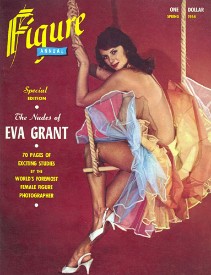
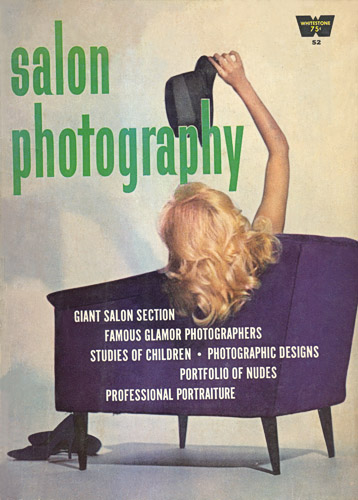
Figure Annual Spring 1964 The Nudes of Eva Grant
Salon Photography (1964) This issue features the work of several glamour photographers profiled on this site, including Eva Grant (5 images), Peter Gowland (2), Andre de Dienes (3), Frank Bez (1), Ron Vogel (2), Mario Casilli (2), Danny Rouzer (1), and Edmund Leja (1 image)
To read more glamour photographer profiles, please go to the "Peter Gowland", "Bunny Yeager" and "More Photographers" pages.